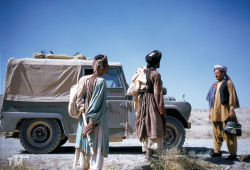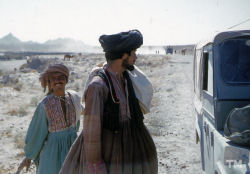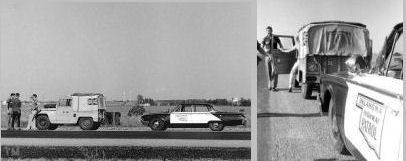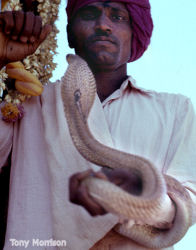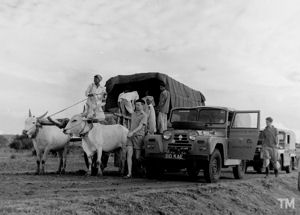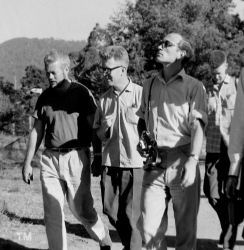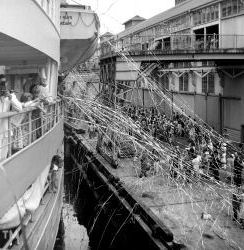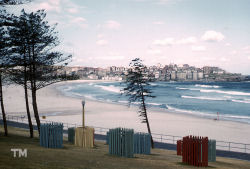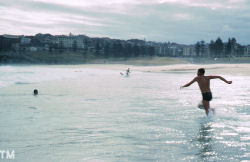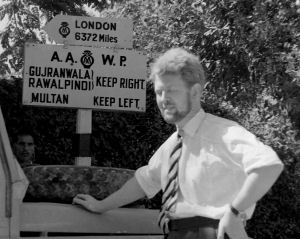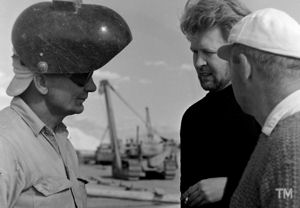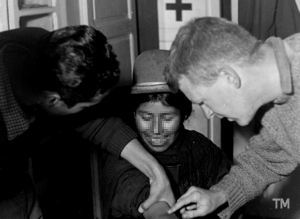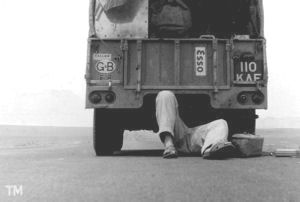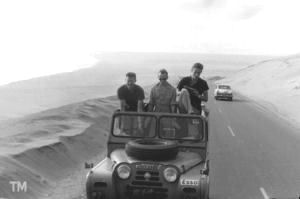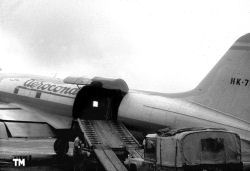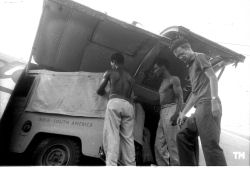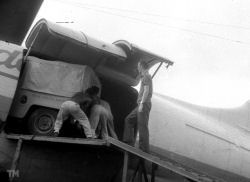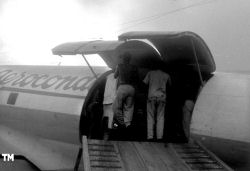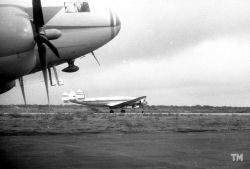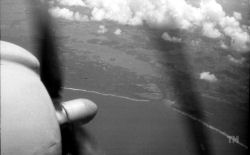| ||||||||||
Memoirs | ||||||||||
Looking
back at the epic journey the members of the team have special memories | ||||||||||
TONY MORRISON and MALCOLM McKERNAN - Bristol, February 1960, - Fundraising had to start somehere. The ambitious expedition idea had just been launched on the unsuspecting University and City. We had given ourselves less than eight months to draw together support and funding and our day-to-day account was pitifully small. We depended on our own cash for postage and printing. For the trip around the world we had each promised £250.00 or just less than half a year's salary for a junior teacher. We knew there was a long way to go towards our back-of-the-envelope target of £10,000 and a lot depended on a meeting with one of Bristol's most influential business leaders. The luck lay in a chance meeting I had a couple of yeras earlier. Fifty yards from a public footpath
We were fifty yards off a public footpath and it could have been taken as as a 'trespass'. I remember my apprehension when I was hailed by an elderly man with a shotgun and accompanied by a couple of farm workers. He was not challenging, simply inquisitive. "What are you doing - what camera - what plants - which university and so on". We chatted for ten minutes, possibly more and he was clearly fascinated. "If you ever need any help with your studies let me know.. remember my name - Foster Robinson".
Now it was 1960 and time was short Malcolm McKernan was the spokesman, diplomat and senior member and above all he had bearing of a mature student and a masterful command of English. Some years earlier he had gained a science degree and worked in industry before deciding to change to drama and writing at Bristol. Malcolm reckoned we had to be purposeful and responsible which in 1960 meant clean-cut hair, pressed suits, shirt and a tie. I decided I needed a shave and a haircut. Just a few steps from the University there was a barber's shop and fifty years ago it was a traditional place with a red and white pole over the door. Even with prices well beyond student means I stepped inside for the first of only two cut-throat razor shaves I have ever had. It came with lashings of foam, warm towels and once the first, very deft cut had been made it was totally relaxing - or at least it diverted my mind from the pending meeting. We were ushered into the office of Sir Foster Gotch Robinson one of the wealthiest men in Bristol and at at one time the Master of The Society of Merchant Venturers.[1943-1945].A group with a unique history for funding exploration. A simple tray of tea and biscuits was offered and enjoyed with a very convivial chat about the Expedition. "How much do you need?" As we explained the cash situation which at the time = Nil + one gifted Austin Gipsy the conversation slowed. Sir Foster pondered. Our budget on paper meant we needed ten thousand Pounds. "That's a lot of money. He said . "You will have to use a subscription list. You take it to other people and get them to contribute". The subscription list You can guess how we felt. Here was one of the richest and most influential men in Britain and apparently he was offering nothing. Did we glance at each other? I can't remember. Sir Foster must have sensed our despair and broke the silence. "Put me at the top of the list for £1000.00 and use my name. Tell them I'm behind you. It's the kind of idea I like". That of course was not the end of the story and over the next six months the Expedition team worked non-stop from a special office in the Victoria Rooms, then University Union HQ in Clifton. I must add that we had some close run deadlines and one desperate cliffhanger only solved by the university Vice Chancellor at countdown minus a month. We left on schedule. Editorial note: £1000.00 in 1960 was roughly equivalent to £17,000.00 [2008] - based on retail prices / or £39,000.00 [2008] based on average earnings | ||||||||||
PETER KRINKS- Afghanistan, October 1960 and USA July 1961 - The kindness of strangers.
Among my strongest memories are the continual kindness and hospitality offered by strangers, some prosperous, others much less so, in all the countries we traversed. I have space to mention only three examples. On our second night in Afghanistan, the police chief in Farah feared for our safety if we camped as usual in the desert and arranged for us to camp on the lawn of the hotel while he settled on the verandah to keep watch. The following afternoon, when we arrived in Gereshk on the Helmand river to buy food before camping, the town seemed deserted, but we followed the sound of music and came upon a dense crowd of people. They opened a gap for us until we were embarrassed to find ourselves on a large carpeted area surrounded by divans and chairs, to which we were ushered, as if we were honoured guests - but in fact in their hospitable culture travellers are honoured guests. We'd gate-crashed an awards ceremony for local officials. Later, they gave us accommodation.
During our journey through USA, we'd spent a night in Elgin, Illinois with a young couple met on Route 66. The following morning, their neighbours, whom we hadn't yet met, invited us to stay a few days, taking up the attic recently abandoned by their older offspring. The next day, Bill Hay apologised for having to leave us alone in their house for two days while the family went to visit a daughter in her convent. It was an impressive example of trust and we remain grateful to them, as to all our other benefactors. | ||||||||||
ROGER TUTT - India, A Resident Cobra, Pusegaon , November 1960 We were privileged to be offered accommodation in the Government Rest Houses in the villages of our study area in the Satara District of Maharashtra State. The Rest Houses, intended for use by visiting Government officials, were simple but comfortable, spacious bungalows looked after by a resident housekeeper. After spending most nights on our journey to India on camp beds under the stars, this was unexpected sophistication. On
arriving at the Rest House in the village of Aundh we were given a welcoming tour
of the facilities by the housekeeper. Having showed us the living room and verandah,
the three bedrooms and the kitchen area, he took us along a path at the back of
the house. There, to our surprise, was an impressive brick construction…..one
of the grandest pit latrines possible to imagine. A long flight of brick steps ran up to an imposing wooden door. The door opened to reveal a very fine hardwood bench seat with the requisite hole set over a very large and deep pit way below. We could only imagine that this magnificent facility had been constructed for a very important visitor, perhaps a visiting maharaja. When we returned to the house, the housekeeper had a warning for us. Earlier in the day he had found a cobra in one of the cupboards in the house and killed it. Cobras, he said, often lived with a mate. We should be careful when opening cupboards in the house although, he added casually, he thought the dead cobra's surviving and possibly vengeful mate actually lived outside the house, probably in the latrine building. Somehow very few visits were made to the latrine after dark, and even fewer after our team doctor Don had needed to administer morphine to a student at a nearby residential school who had been bitten by a scorpion. The student survived. But his cries of pain penetrated the night for some time after he was given the morphine. The visits that still had to be made involved a very tentative opening of the door and an elaborate search of the interior with a kerosene lamp. But you couldn’t illuminate all areas. What if that bereaved cobra was lodged under the plank, close to the hole?” | ||||||||||
PETER
KRINKS, India - A close shave, November 1960
On 23 November, three of us had to travel from Aundh to Bombay for some meetings. As usual, rural stretches of the two-lane road weren't busy, but at one point, while Malcolm was driving, we were catching up to a large, slowly moving lorry. Soon, it pulled out to overtake a heavy wooden ox-cart - even its wheels were of wood - and Malcolm followed in its track. The lorry then moved back to the left of the road, revealing an equally large lorry coming towards us. Neither vehicle could brake quickly enough. The ox-cart driver was unaware of the danger and held his course to our left. The lorry driver had little room to risk moving to the minimal verge on his left, so he too held course and Malcolm had no choice but to do the same - gripping the wheel rigidly, but not panicking and bringing the Gipsy through with not an inch to spare on either side. I think the aftermath was merely a series of relieved profanities, mingled with congratulations to Malcolm for holding his nerve. | ||||||||||
PETER KRINKS - Australia, January 1961 When the ms Willem Ruys docked in Melbourne on 31 January 1961, we were greeted by Jim Davern, whom we had met in Tehran. He was a television writer/producer with the Australian Broadcasting Commission and was driving from England to India in a Volkswagen beetle, alone. He introduced us to the Australian barbecue at Jimmy Watson's pub, where we bought huge steaks which we cooked ourselves, with a modest amount of red wine. He then drove us to a wildlife sanctuary to meet koalas, kangaroos and emus for the first time. Late in the afternoon he explained that the pubs closed at six (preceded by the `six o'clock swill'), and took us to his place for a beer before driving us back to the ship. He later became famous in Australia for his series Bellbird on the ABC, and the still more popular - A Country Practice on Channel 7 TV.
We then spent a surprisingly dull 36 hours in Sydney. A bus trip to Bondi beach revealed ugly blocks of flats along the main road and the beach was swept by a strong cold southerly wind; only Mark was brave enough to try swimming. We gave a brief talk on ABC radio and then walked up to see the glitter and excitement of Kings Cross. That Thursday evening it was so flat that espresso bars offered the only stimulus. The next day we did enjoy climbing a pylon of the harbour bridge, and walking through Hyde Park and the Domain, but the most dramatic part of the visit was the departure from Woolloomooloo wharf. Not only were there hundreds of new passengers throwing coloured streamers to their wellwishers, but just as the ship began moving a late crewman dived into the harbour, to be dragged aboard through a low hatch.Now, after living in Sydney for forty years, I have discovered the wide range of its attractions and regularly enjoy the wooded parks and reserves, the good, cheap eating places, the art galleries, theatres and concerts and North Sydney's Olympic Pool. | ||||||||||
DONALD PILTON - Doctor, medical officer and cook - some reflections.
When I heard of the expedition driving round the world in 1960 it was the sort of thing I had dreamed of so I rushed around and explained to them the danger of rabies, scorpion stings, typhoid, cholera, etc etc and offered my services which were instantly accepted. I spent the next few months packing a large medical kit in a steel box with wound dressings, plaster of Paris for fractures, many antibiotics and analgesics including morphine and dental equipment for tooth extraction. All the kit was used on the journey. I also took a week's course in dental extraction and bought the Ships Doctors Medical Handbook which contained simple advice on emergency dentistry. All of us were checked by Dr.Alan Rogers our medical adviser who had been with the Commonwealth Trans Antarctic Expedition 0f 1955-58 and who gave me the right kind of encouragement for our journey. We had a wonderful send off by the Lord Mayor of Bristol and felt very grand as we left the city with a police escort. The first incident was camping in Turkey when we all heard something moving around our camp and on investigation it proved to be an extremely large spider -possibly a tarantula. I have never seen six men break camp and pack their vehicles so quickly.
The next incident I remember vividly was in Iran when we stopped at an American oil pipeline and drilling area. One of the workmen had severely injured his arm in the fan of a big generator. I repaired, stitched and dressed his wounds. I was offered a very highly paid job as the medical officer which I of course declined. We dined on king prawns and steak that evening. In eastern Iran I went out in the morning from the camp and became surrounded by a small pack of large wolves but managed to return to camp safely. Then it was through Afghanistan complete with Biblical scenes and down the Khyber Pass where the next stop was Amritsar and the Golden Temple where the priests were very hospitable and offered us a room. Then on to the small Princely State of Aundh on the Deccan where within minutes of our arrival a large American car arrived to take me to the Palace where the Raja was ill. On arrival at the Palace the Raja's army was there complete with armed elephants and a band which played Rule Britannia as I went to attend the Raja. I was invited to stay at his Palace in Poona (Pune) which I did. Back in Aundh I treated a young man who had been stung by a scorpion and was screaming. I gave him morphine and he soon settled. At the time there were outbreaks of cholera in many parts of India and a large smallpox epidemic which killed thousands. I was feeling safe because my arm had been scratched in England. [Editorial note. Smallpox was a disease feared worldwide for centuries and only finally accepted as eradicated in 1980. The Expedition team like all travellers received a 'scratch' of vaccine on the arm before leaving Bristol] I was summoned to dine by the Maharaja of Baroda which was quite memorable. On the way south we stopped at Oooticamund [now Udhagamandalam] in the Nilgiri Hills, the home of a British tea planter. I diagnosed his wife's fractured scaphoid and plastered it. [Ed: a small bone in the wrist] Then for the second time within a three months I was offered a highly paid job running four hospitals which were on the plantation. From the refreshingly cool climate of 'Ooti' we continued south to Sri Lanka where the giant lizards of more than 2 metres came as a surprise to us.
Then we travelled by sea to Peru and up to the Altiplano and La Paz, a very beautiful city at 12,000 feet. Being fit we had no problems with altitude sickness. There was plenty of ice and snow on the Altiplano and we slept outside in our double sleeping bags with our Morland sheepskin jackets, gloves and hat. Then down to the Amazon jungle where we approached a small village comprised of mud huts with roofs made of giant palm leaves. A man emerged in his underpants and I was thinking in terms of head shrinkers when he uttered the memorable words 'would you like a cup of tea?' Medically I noticed many people there had large goitres of the thyroid and some of the children appeared to be cretins due to lack of iodine. [Editor's note: cretin= medical term for stunted physical and mental growth due to iodine deficiency - all signs of this problem have disappeared with the economic rise of the Bolivian lowlands] One final thought, there we were, six young men living very closely together for more than one year and I had been expecting friction and personal difficulties. Fortunately nothing like that arose and we all stayed well during an extremely exciting journey. And thankfully nobody needed any dental treatment! [Editorial comment - This account covers 1961 when snow and ice on the Altiplano and nearby mountains was a common sight. In 2009 when the memoir was written snow, ice and water were rare due to climate change]
ROGER TUTT - PERU, Ravine approaching: Whoops, no brakes! January 1961 We quickly grew very fond of our two Austin Gypsies. They performed impressively in some very testing conditions, and their unique suspension system gave a comfortable ride on the corrugated, un-metalled surfaces with which we were to become very familiar. But the design was new and there were teething troubles, some quite disconcerting.
There was a particular problem with the front stub axles. You had only the briefest warning of stub axle failure. First, the brake hydraulics would start to go, and then a wheel would fly off! The road south from Lima runs along the coast through the Atacama desert . As I recall, the road frequently dropped steeply to narrow, single-track bridges of some 50 metres or so in length to cross deep ravines coming in from the sea, before climbing steeply again on the other side of the bridge. (Photo?) There were, I remember , fairly substantial ditches on each side of the carriageway. And, of course, as I started to head down to one such bridge, those unmistakable signs of stub-axle failure appeared. “No brakes” I must have muttered to my companions, through clenched teeth, as I tried to guess whether it would be better to attempt to crash the heavily-loaded vehicle into the ditch, and hope it would stop before reaching the bridge, or to attempt to steer straight across the bridge at an uncomfortably fast speed and just pray that the wheel stayed on until we reached the other side. I think we’d discovered that pumping the brakes in these circumstances simply caused the wheel to depart that much sooner! So, despite the reckless speed, I kept my foot away from the brake pedal and concentrated on steering across that very narrow bridge. As we reached the other side, and the road started to climb, the wheel shot off ahead of us, and I managed to put the Gypsy into the ditch, hoping that we wouldn’t roll backwards towards that deep ravine. For a while the Atacama air was blue - and then Mark calmly worked mechanical miracles with a spare stub-axle at the roadside - once again. A few weeks later in La Paz we received the first re-designed stub-axles from Austin.
ROGER TUTT - Low-flying over Castro's Cuba, July 1961 In
June and July 1961 we drove from Bolivia via Peru and Ecuador to the north coast
of Colombia. We'd been aware for some time that our plan to use a new section
of the Pan-American Highway to bridge the Darien Gap in Panama was no longer realistic.
The new section hadn't been started, let alone finished (and it still awaits construction
now.) I explained
our predicament. He had no doubt that his plane could carry two heavily loaded
vehicles. I confessed that we could only pay the £200 budgeted for the short
sea trip. As I recall, he settled for US$500, gave me instructions to find the
airstrip and insisted that we be there "by first light". | ||||||||||
| ||||||||||
We
lined up at the end of the strip with an Avianca, [Colombian airline], Lockheed
Super Constellation and waited. The take-off must have been one of the most optimistic
ever attempted from that airfield. The fully-revved engines took forever to get
the over-laden aircraft to move at all. Eventually we managed to get airborne,
but with insufficient height to avoid removing the tops of the palms at the end
of the strip.
The plane never did manage to climb to much more than 2000 feet. As most of the route was over the Caribbean, this was of little concern to our easy-going pilot. But I recall that even he became twitchy as we approached the coast of Fidel's Cuba at a height well below the minimum for any transit flight. It was only few months since the Bay of Pigs debacle and the Cuban Missile Crisis was yet to come. In the event, we made it to a remote corner of Miami International Airport with yellow flashing lights surrounding us….and a big bill from the US Department of Agriculture for jet washing South American mud and dust from the vehicles
| ||||||||||
| ||||||||||
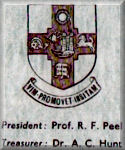
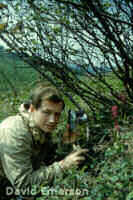 It
was my last year as a student and with cheerful encouragement from David Emerson
a fellow zoologist I was working on a personal study project in woodland not far
from Bristol.
It
was my last year as a student and with cheerful encouragement from David Emerson
a fellow zoologist I was working on a personal study project in woodland not far
from Bristol.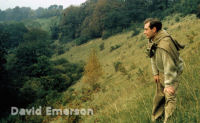 In my final year at school before university my studies had been directed by Ernest
Neal who was a leader in the ecology field with his work Woodland Ecology
- a gem for anyone looking for the beginnings of what is now a movement]
In my final year at school before university my studies had been directed by Ernest
Neal who was a leader in the ecology field with his work Woodland Ecology
- a gem for anyone looking for the beginnings of what is now a movement]